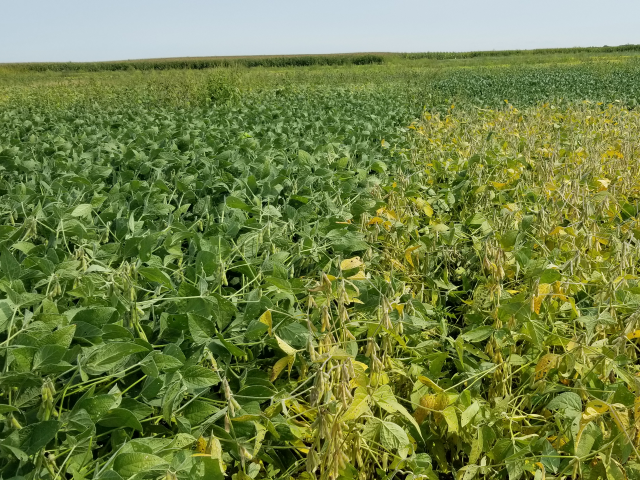By: Fabiano Colet and Laura Lindsey
Seeding rate
Soybeans planted in June tend to be smaller and have fewer nodes and pods than soybeans planted in April or May. Therefore, the recommendation is to increase the seeding rate when the planting date is delayed. A small-plot field study conducted at Western Agricultural Research Station (WARS) in South Charleston, Clark Co., and Northwest Agricultural Research Station (NWARS), in Custar, Wood Co. for two growing seasons identified the agronomic optimum seeding rate (the seeding rate where soybean yield is maximized). Conclusions regarding the seeding rate for June planting dates are shown in Table 1. For the first half of June, seeding rate should be between 150,000 to 180,000 seeds per acre. For the second half of June, increase seeding rate to 170,000 to 200,000 seeds per acre.
Table 1. Agronomic optimum seeding rate (where soybean yield is maximized) for early and late June planting dates in western and northwest Ohio.|
|
Western Ag. Research Station (WARS) |
Northwest Ag. Research Station (NWARS) |
|
|
Seeding rate in seeds/acre |
|
|
June 1 – June 15 |
150,000 – 170,000 |
160,000 – 180,000 |
|
June 16 – June 30 |
170,000 – 190,000 |
180,000 – 200,000 |
Row spacing
For soybeans planted in June, the recommendation is to use narrow rows (7.5-15 inch row spacings). Soybeans planted in narrow rows tend to out-yield soybeans planted in wider row width (30-inch) because it intercepts more sunlight. Narrow width-rows can also positively influence soybean yield by improving weed control by shading out weeds and helping retain soil moisture.
Relative MaturityRelative maturity (RM) plays a role in soybean production. When planting in June, farmers may need to choose a cultivar that will reach physiological maturity before the first killing frost. Choosing varieties with the preferential relative maturity for that planting period will allow plants to grow vegetatively as much as possible before reducing speed of vegetative growth during reproductive stages. This will reflect in the production of nodes, pods, and seeds. The recommended relative maturity ranges are shown in Table 2.
Table 2. Recommended relative maturity ranges for soybean varieties planted in June in Northern, Central and Southern Ohio.|
|
Planting Date |
Suitable Relative Maturity |
|
Northern Ohio
|
June 1-15 |
3.2 - 3.8 |
|
June 15-30 |
3.1 - 3.5 |
|
|
Central Ohio
|
June 1-15 |
3.4 - 4.0 |
|
June 15-30 |
3.3 - 3.7 |
|
|
Southern Ohio
|
June 1-15 |
3.6 - 4.2 |
|
June 15-30 |
3.5 - 3.9 |






